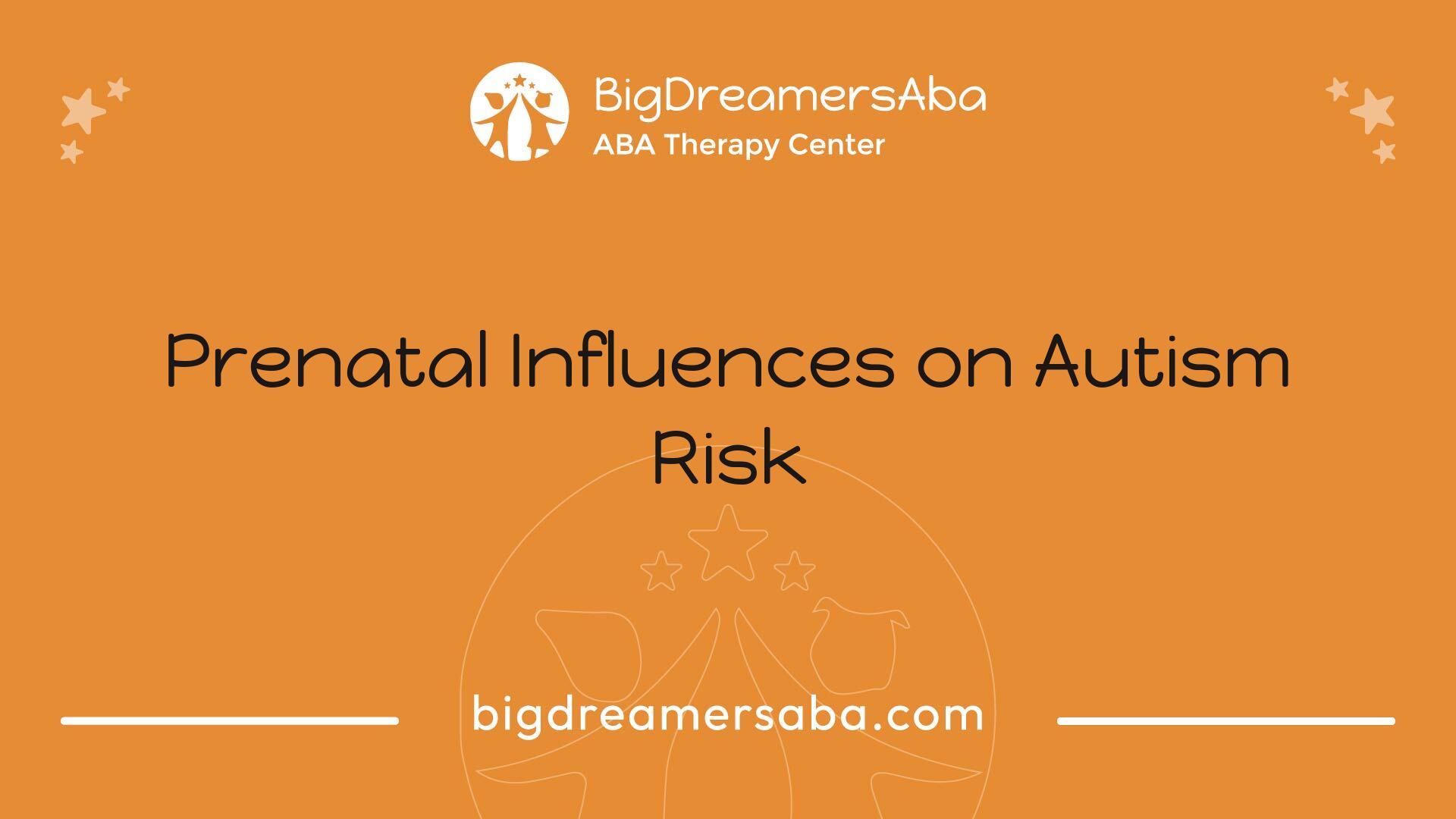Environmental Causes & Risk Factors in Focus
Explore the environmental causes & risk factors of autism, from genetics to prenatal influences, in this insightful guide.


Understanding Autism Risk Factors
Understanding the factors that contribute to autism is critical for researchers and families alike. Autism spectrum disorder (ASD) is influenced by a combination of genetic and environmental factors.
Genetic Influences on Autism
Genetic factors play a significant role in the development of autism. Researchers have identified rare gene mutations as well as common genetic variations that correlate with the disorder. This implies that genetics contributes to the risk of developing autism, but the exact nature of these genetic influences is still being studied. The interplay between genetics and environmental factors is increasingly recognized as a critical area of research. For instance, a woman’s exposure to harmful substances during pregnancy could trigger genetic mutations leading to autism in her child, as highlighted by studies on gene-environment interactions.
Genetic Risk FactorsDescriptionRare MutationsAssociated with specific cases of autism, often inherited.Common VariationsVariants found in the general population that may increase risk when combined with other factors.
Environmental Factors and Autism
Environmental influences are also significant in the risk factors associated with autism. Several studies indicate that various prenatal exposures can contribute to the likelihood of developing ASD. Common environmental risk factors include:
Additionally, advanced parental age, especially paternal age, is also a key risk factor. Fathers aged 34 to 39 have a nearly two-fold greater risk, while those over 40 have more than twice the risk compared to fathers aged 25 to 29. Understanding these factors is important for developing preventative strategies and supporting those affected by autism.
Environmental Risk FactorsDescriptionInfections during pregnancyMaternal exposure to certain infections can increase autism risk.MedicationsSpecific medications taken during pregnancy have been implicated in increased risk.Advanced parental ageOlder parental age, particularly for fathers, correlates with higher autism risk.
Exploring the environmental causes & risk factors of autism provides valuable insights that can help enhance prevention efforts and inform families about potential risks. Understanding both genetic and environmental contributions allows for a more comprehensive approach to autism research and support.
Prenatal Influences on Autism Risk

Understanding the prenatal influences on autism risk is crucial for parents and healthcare professionals alike. Both maternal health factors and environmental exposures during pregnancy can significantly impact neurodevelopment.
Maternal Health Factors
Maternal health plays a vital role in determining the risk of autism spectrum disorder (ASD) in children. Research indicates that problems with a mother’s immune system, certain metabolic conditions, or inflammation during pregnancy may be linked with a higher autism risk for her children [1].
One key factor is the use of prenatal vitamins. Studies funded by the National Institute of Environmental Health Sciences have found that taking prenatal vitamins may help lower autism risk. Prenatal vitamins typically contain higher amounts of folic acid, iron, and B vitamins, which can have a protective association with ASD when used during pregnancy or preconception [3].
Maternal Health FactorImpact on Autism RiskImmune system issuesHigher riskMetabolic conditionsHigher riskInflammationHigher riskPrenatal vitamin useLower risk
Environmental Exposures during Pregnancy
Environmental factors also play a significant role in autism risk. A growing area of research focuses on the interaction of genetic and environmental factors. For instance, a woman’s exposure to harmful contaminants during pregnancy may trigger a genetic mutation leading to autism in her child [1].
The benefits of prenatal vitamins extend beyond maternal health; they might also provide protective effects for those exposed to certain environmental contaminants during pregnancy. The use of multivitamin supplements during preconception or pregnancy has shown inverse associations with autism spectrum disorder, indicating a decreased risk of ASD in children of mothers who took these supplements.
Given that the rate of autism is rising, understanding these prenatal influences is an essential component of addressing the environmental causes and risk factors of autism.
Early Life Exposures and Autism

Children's early life exposures play a significant role in their neurodevelopment and can potentially influence the risk of autism. Two critical factors that have garnered attention in relation to autism are air pollution and exposure to heavy metals.
Air Pollution and Autism Risk
Recent studies have demonstrated a concerning link between air pollution exposure during pregnancy and an increased risk of childhood autism. Research conducted in Scania, Sweden, has shown that exposure to local PM2.5, particularly from sources such as residential wood burning and road traffic emissions, correlates with a heightened risk of autism in children.
The findings suggest that pollutants such as particulate matter can impact fetal brain development, leading to neurodevelopmental disorders. Table 1 summarizes the key findings related to air pollution and autism risk:
Study LocationPollutantAssociation with Autism RiskScania, SwedenPM2.5 (from wood burning and traffic)Increased risk of childhood autism
These results support the growing consensus that environmental factors, including air quality, are crucial considerations in understanding the environmental causes & risk factors of autism.
Heavy Metals and Neurodevelopment
Heavy metal exposure during early development has also been implicated in neurodevelopmental disorders, including autism. Common heavy metals of concern include lead, mercury, and cadmium, which can be found in various environmental sources such as contaminated water, food, and air.
Studies suggest that even low levels of heavy metal exposure can have detrimental effects on brain development in young children. The neurotoxic properties of heavy metals can interfere with critical processes required for normal brain development, potentially leading to increased autism risk.
The relationship between heavy metals and autism can be summarized as follows:
Heavy MetalSourcesPotential Impact on NeurodevelopmentLeadContaminated water, soilNeurodevelopmental delays, cognitive deficitsMercuryFish consumption, dental amalgamsImpaired motor and cognitive skillsCadmiumIndustrial exposure, contaminated foodDisruption of neurotransmitter release
Due to these concerns, it is essential for expectant mothers and caregivers to be aware of potential sources of heavy metal exposure and take measures to minimize risk.
Understanding the environmental influences such as air pollution and heavy metal exposure is crucial for comprehending risk factors associated with autism. For more information on autism and its causes, consider exploring insights on what is the autism creature or reviewing resources such as new jersey autism resources.
Epigenetic Factors in Autism
Understanding the role of epigenetics in autism provides valuable insights into how environmental factors influence gene expression. Epigenetic factors can impact developmental outcomes and risk factors for autism.
Impact of Early Experiences
Early experiences can leave a chemical "signature" on genes, known as the epigenome, which determines gene expression. Positive experiences, such as educational and social opportunities, alongside negative influences, like malnutrition or exposure to environmental toxins, can modify the chemistry of gene encoding in brain cells either temporarily or permanently through a process called epigenetic modification.
Experiences during the impactful early years can dictate how genes are turned on and off, significantly affecting the expression of certain genes critical to brain development. For instance, the development of brain architecture relies on the activation of specific genes at particular times, which can be shaped by the experiences children undergo in their formative years.
Experience TypeInfluence on Gene ExpressionPositive (Learning opportunities)Potentially enhances brain developmentNegative (Toxic exposure)May hinder neurodevelopment
Epigenetic Modifications and Gene Expression
Epigenetic markers control gene expression by turning genes "on" or "off." The alteration of these epigenome markers can have significant long-term effects on both physical and mental health [5]. These modifications highlight the importance of providing nurturing and supportive experiences, particularly during rapid brain growth in the earliest years.
Moreover, genes are susceptible to modification due to adverse factors such as toxic stress and nutritional deficiencies. It emphasizes the critical importance of ensuring young children are in supportive environments, as these factors greatly affect their risk for developmental disorders, including autism. Studies have shown that postnatal risk factors like low birth weight are correlated with a higher risk of autism, with neonates having birth weights below 2500g experiencing a two-fold increase in these risks [2].
Exploring the environmental causes and risk factors of autism necessitates considering both genetic and epigenetic perspectives, reinforcing the importance of early intervention and supportive conditions for children.
Nutritional Factors and Autism
Nutritional factors play a significant role in the environmental causes and risk factors of autism. This section focuses on the impact of prenatal vitamins and maternal diet on neurodevelopmental outcomes in children.
Prenatal Vitamins and Autism Risk
Prenatal vitamins are crucial for expecting mothers as they provide essential nutrients that support fetal development. Research indicates that taking prenatal vitamins, particularly those rich in folic acid, iron, and B vitamins, can help lower the risk of autism spectrum disorder (ASD) in children. Studies have shown that the use of multivitamin supplements during pregnancy or preconception is associated with a reduced risk of ASD.
The protective effects of prenatal vitamins are particularly pronounced for mothers who may be exposed to environmental contaminants during pregnancy. Supplementing with vitamins and minerals helps mitigate the adverse effects of these exposures.
NutrientPotential BenefitsFolic AcidMay reduce risk of ASD; supports neural tube developmentIronEssential for brain development; prevents anemiaB VitaminsImportant for brain function and overall health
Maternal Diet and Neurodevelopment
The maternal diet during pregnancy significantly influences neurodevelopment in children. Nutritional deficiencies can adversely affect brain development and may be linked to an increased risk of autism. High-quality diets rich in fruits, vegetables, whole grains, and lean proteins are associated with better outcomes in child development.
Studies have suggested that maternal folic acid supplementation, along with maintaining a balanced diet, is associated with a lower risk of ASD [3]. However, it is important to note that some research reports conflicting findings, prompting further investigation into the relationship between folic acid intake and autism risk.
A well-rounded maternal diet can help support healthy fetal development and may contribute to decreased risks related to neurodevelopmental disorders. For information on autism resources and support, check our guides on New Mexico autism resources and New Jersey autism resources.
Parental and Postnatal Risk Factors
The risk factors for autism extend beyond genetics and environmental influences. Parental age and various postnatal conditions can also play significant roles in determining the likelihood of autism in children.
Advancing Parental Age
Research highlights that advancing parental age, particularly paternal age, is a notable risk factor for autism. Fathers aged between 34 and 39 years are associated with nearly double the risk of having a child with autism, and those over 40 have more than double the risk compared to fathers aged 25-29. Studies conducted in Japan and China corroborate this finding, indicating a consistent relationship between paternal age and increased autism risk [2].
A summary of findings on parental age and autism risk is presented in the table below:
Parental Age GroupIncreased Risk of Autism25-29 yearsBaseline Risk34-39 yearsNearly 2-fold increase40 years and olderMore than 2-fold increase
While maternal age has been scrutinized, studies indicate it does not show a significant correlation with autism susceptibility. Additionally, parental psychiatric history can contribute to autism risk, with disorders such as schizophrenia linked to nearly three times the risk of autism. Conditions affecting maternal mental health, such as depression, anxiety, and personality disorders, have also been associated with increased autism susceptibility [2].
Postnatal and Natal Risk Factors
Postnatal factors can significantly influence the risk of autism. Low birth weight is particularly concerning; neonates weighing less than 2500 grams face a two-fold increase in autism risk. Other postnatal concerns include jaundice and infections during the first 30 days of life, such as meningitis and ear infections, which have shown correlations with a heightened risk of autism [2].
Certain natal factors, which encompass conditions around birth, also pose risks for autism. Complications during birth, prenatal bleeding, and fetal nuchal cord issues have been identified as significant risk factors. Preterm and postterm births may further increase the risk of autism as well [2].
A summary of postnatal risks is provided in the following table:
Postnatal/Natal ConditionAssociation with Autism RiskLow Birth Weight (<2500g)2-fold increaseJaundiceIncreased RiskMeningitisIncreased RiskEar InfectionsIncreased RiskPrenatal BleedingIncreased Risk
Understanding these parental and postnatal risk factors is crucial when exploring the environmental causes & risk factors of autism. By raising awareness, families can take proactive steps toward monitoring and addressing risks associated with autism.
References
[2]:
[3]:
[4]:
[5]:
Recent articles

ABA Techniques for Picky Eaters: Building Better Habits

How Social School Support Makes School Transitions Easier for Children
